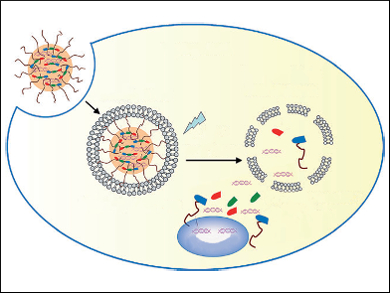The development of vectors for gene therapy is often hampered by the fact that nonviral vectors become trapped in endo/lysosomes after endocytosis and the nucleic acids that are being transported end up being destroyed. Bin Liu and colleagues, National University of Singapore and Agency for Science, Technology and Research (A*STAR), Singapore, have come up with a polymeric gene delivery vector that can not only escape from endo/lysosomes, but also unpack DNA in one light excitation process.
The researchers designed a gene delivery vector that contains a photosensitizer, an aminoacrylate linker that can be cleaved by reactive oxygen species (ROS), and poly(ethylene glycol) units for water solubility. In aqueous media, the polymer self-assembles into nanoparticles that show a bright red fluorescence and can bind to DNA by electrostatic interactions. After endocytosis, the nanoparticles are trapped in endo/lysosomes.
Irradiation with light results in two concurrent processes (see picture): the formation of ROS, which destroy the endo/lysosomal membrane, and DNA release upon breaking of the polymer when the ROS-reactive linkers are cleaved. Studies showed that the released DNA accumulated in nuclei, and that the transfection efficiency of the system was 50 % more higher than that of commercially available products. This strategy should be applicable to therapeutic DNA or siRNA for gene therapy.
- A Photoactivatable AIE Polymer for Light-Controlled Gene Delivery: Concurrent Endo/Lysosomal Escape and DNA Unpacking,
Youyong Yuan, Chong-Jing Zhang, Bin Liu,
Angew. Chem. Int. Ed. 2015.
DOI: 10.1002/anie.201503640




